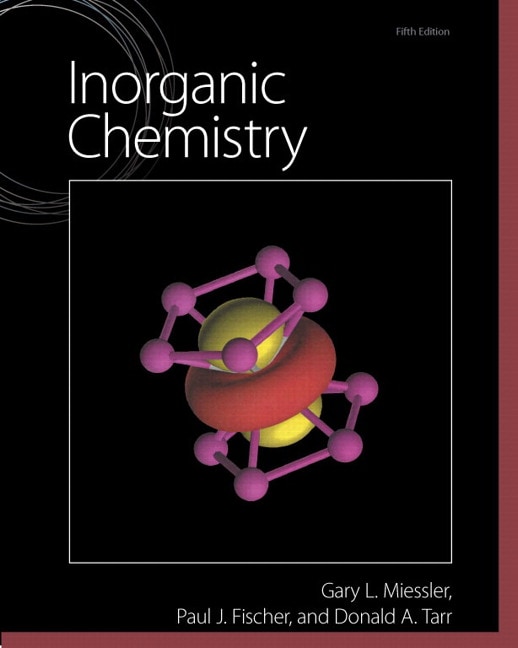

Descriptive inorganic chemistry 6th edition rayner canham solutions manual
Descriptive Inorganic Chemistry 6th Edition Rayner Canham Solutions Manual Full clear download (no error formatting) at : https://testbanklive.com/download/descriptive-inorganic-chemistry6th-edition-rayner-canham-solutions-manual/
Chapter 2 AN OVERVIEW OF THE PERIODIC TABLE Exercises 2.2
(a) Energy needed to remove the second ground-state electron from an atom (X+ → X2+ + e−). (b) Energy needed to add an electron to the lowest available energy state of an atom. (c) For each essential element, there is a range of intake from too low to optimal to excess.
2.4
The common isotope of cobalt has more neutrons than that of nickel, hence the atomic mass will be higher. In fact, the only natural isotope of cobalt has 32 neutrons, while nickel has two common isotopes, one with 30 neutrons (68 percent), the other with 32 neutrons (26 percent).
2.6
Throughout recorded history, copper, silver, and gold have been used to make coinage. The metals are easy to extract from their ores and have been known for thousands of years. They are unreactive, ensuring a long circulation life for the coins. On the other hand, they are now so expensive that they are no longer used (the current U.S. penny consists of a copper coating over a lower-cost zinc core).
2.8
The ending -ide traditionally is used to identify the anion of an element (fluorine–fluoride), so the suffix is inappropriate for the group of elements themselves.
2.10
The only way in which high-atomic-number elements can be formed is by means of the energy from supernova explosions (iron is the highest
atomic-number element that is formed exothermically by fusion reactions). Hence these elements on this planet must have been formed from such an explosion billions of years ago.
3
4
Chapter 2
2.12
Uranium and thorium. Both of these elements have isotopes with halflives in the 109–1010 year range; hence a considerable proportion of these elements are still present from their original supernova synthesis (we now know that bismuth only exists as a very long half-life isotope).
2.14
20 (because 20 protons and 20 neutrons would give a doubly completed shell nucleus).
2.16
Both polonium-210 and astatine-211 have 126 neutrons, the filled-shell value, giving additional stability to the isotopes.
2.18
Elements with some chemical and/or physical properties that resemble metals and others that resemble nonmetals. Alternative answer: elements with properties that are intermediate between those expected for a metal and those expected for a nonmetal.
2.20
Chlorine. With increasing “layers” of electrons, the effective nuclear charge on the outermost electrons will decrease (even though the actual number of protons has increased). Hence the atom of chlorine will have the greater covalent radius.
2.22
With the very poorly shielding 4f orbitals having been filled corresponding to the added protons, the effective nuclear charge on the outer (6s and 5d) electrons will be increased; hence the covalent radius will decrease.
2.24
Effective nuclear charge on 1s = 18.65; 2s/2p = 14.85; 3s/3p = 7.75; 4s = 2.20.
2.26
Effective nuclear charge on 3p electrons in aluminum = 3.50, in chlorine = 6.10. The higher effective nuclear charge on the outermost electrons in chlorine results in that element having the smaller atomic radius of the two and the higher first ionization energy.
2.28
Phosphorus. With increasing “layers” of electrons, the effective nuclear charge on the outermost electrons will decrease (even though the actual
An Overview of the Periodic Table
5
number of protons has increased). Hence the atom of arsenic will have the lower ionization energy. 2.30
Electron configurations: B = 1s22s22p1; C = 1s22s22p2; N = 1s22s22p3. For carbon and nitrogen, the second ionization energy requires removal of a second 2p electron. Because the 2p electrons of nitrogen experience the higher effective nuclear charge, nitrogen will have the higher second ionization energy. For boron and carbon, the second electron removed from the boron will be a 2s. Although the simplistic Slater’s rules show the shielding the same as for 2p electrons, in fact the 2s electrons are held more strongly than the 2p. Hence boron will have the higher second ionization energy.
2.32.
Magnesium. With a filled 3s2 set of electrons, magnesium is less likely to accept an electron (which would have to go into the 3p orbitals) than sodium with a 3s1 configuration (the added electron then giving a “full� 3s2 configuration).
2.34
The first four periods of the periodic table (especially the first three periods). This corresponds to the elements of higher abundance (for example, iron is the most abundant of the transition metals, and it is the only transition metal required in large dietary amounts).
Beyond the Basics 2.36
For lead, the very poorly shielding 4f orbitals having been filled corresponding to the added protons, then the effective nuclear charge on the outer (6s and 6p) electrons will be greater than that on the 5s and 5p electrons of tin. As a result, the first ionization energy of lead will be greater than that of tin.
2.38
Our agricultural products absorb elements from the soil in which they are grown. If the soil in a particular region is deficient in an element, then so will be the foods grown there. By obtaining our foods from different locations, we minimize this problem and enhance the probability of a more elementally balanced diet.
6
Chapter 2
2.40
For both Uuh and Uuo, the known isotopes are even proton – even neutron species. For Uuq and Uup, unexpectedly, elements with both odd and even numbers of neutrons are known. It is of note that the ‘missing’ element 117 is an odd-proton species and therefore less likely to be stable than even-proton even-neutron species.
Descriptive Inorganic Chemistry 6th Edition Rayner Canham Solutions Manual Full clear download (no error formatting) at : https://testbanklive.com/download/descriptive-inorganic-chemistry6th-edition-rayner-canham-solutions-manual/ descriptive inorganic chemistry 6th edition pdf descriptive inorganic chemistry 6th edition pdf download descriptive inorganic chemistry 6th edition solutions descriptive inorganic chemistry rayner-canham descriptive inorganic chemistry 5th edition rayner canham

0 thoughts to “Descriptive inorganic chemistry 5th edition pdf download”